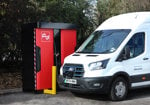Satellite navigation devices are now so common that modern motorists barely give them a thought.
Switch it on, type in an address, press start and follow the mellifluous voice to your destination.
But behind the scenes of the sat-nav industry, a huge amount of work is continuously under way to ensure that the maps you follow are up to date and accurate.
Without these maps, the carefully constructed algorithms worked out by the equipment suppliers would be useless.
As such, the mapping companies that sell the base maps to the telematics companies are vital.
One of the world’s largest such firms is Navteq.
Founded in 1985, the American firm now has offices around the globe, including six in the UK.
It has mapped in 73 countries on six continents and logged 22 million points of interest, such as hotels and garages.
But when the company first set up in the UK, it had to create maps of Britain from scratch.
Doing so required the use of a wide range of sources, from paper maps and local authority data to aerial photographs and bespoke surveying.
Staff went through road data going back to the 1920s to get the UK map off the ground and work is always continuing to keep it up to date.
This includes the locations of roads but also vast amounts of information pertaining to them.
Each section of road in the database contains 260 pieces of information, known as attributes, from speed limit and number of lanes to adjoining businesses and addresses.
“There’s no single way of working – it depends what attributes we are collecting and what we need to do in the timescale,” says Roger Payne, Navteq’s UK operations manager.
“If someone else has created an up-to-date source at the right price, that’s a good starting point.
"But that isn’t available for many attributes – for example, lane markings.
"It’s easier for us to drive down a road and video- capture them rather than try to gather information from a local authority.”
Driving survey vehicles is a large part of Navteq’s work.
It has a fleet of purpose-built vehicles and camera kits to capture images and GPS data from journeys across every mile of the UK’s road network.
“We’re building up an enormous video archive of roads across the world,” says Mr Payne.
The staff behind the wheel – and then behind computers working through the data – are highly trained and usually local.
“It’s important to have local people who know the roads to create and update maps,” says Mr Payne.
“The technology is moving very fast so these people need to be very adaptable.
"The same people that survey complex sites also edit the data to avoid losses in translation.”
Keeping maps updated requires keeping a close eye on the whole UK road network.
The postal service is a useful source of information, as well as updates from customers who can submit changes to Navteq via the web.

Future demands
“When we started, everyone was happy to have just the roads and one-way streets logged,” Mr Payne says.
“We are moving beyond that now.
"People want things that look more lifelike and with increasing processing power now available that is becoming possible.
“We are now including 3D models of cities and landmarks, and 3D street views of 85 cities in Europe.
"We’re also capturing elevation data in case any suppliers want to use it.”
A more safety-orientated development focuses on advanced driver assistance systems (ADAS).
“There are various systems starting to be developed that are providing much more safety-critical information to drivers,” Mr Payne says.
These include warnings about sharp bends and live alerts about “ghost drivers” – motorists travelling the wrong way up a motorway.
Data relating to intelligent speed adaptation is also being gathered as technology moves towards the creation of a self-aware vehicle which can warn or react to its surroundings.
“We’re just on the cusp of this,” Mr Payne says.
“We, as a company, have to provide that data in advance of the systems being rolled out.”
The holy grail of mapping is to work out a way of getting updated information from Navteq to the end user in real time.
“It’s some way off,” Mr Payne admits. “If there’s a message from us to our users it’s about keeping the map up-to-date.
“The only way a system will work at its optimum performance is having the latest map.”
Creating a map
To demonstrate the procedure for creating a map, Fleet News joined Navteq geographic analyst Oliver Hampton as he collected information about a new stretch of road off the M1.
The area in question was a small bypass on the A507 near Woburn.
The weapon of choice was one of Navteq’s surveying vehicles, complete with GPS equipment and six cameras mounted on top.
An image was taken from each camera every metre and logged in giant hard drives strapped into the boot.
The process of collecting data is relatively simple.
The vehicle simply drove down the new roads, looping around roundabouts, and the path taken was displayed on a screen mounted to the dash.
Mr Hampton noted particular features via a microphone, such as road signs and whether when two roads cross they went over or under each other.
Once back at the office, the raw data was uploaded, tidied up by hand and tagged with the information recorded before being uploaded into the main database.
















Login to comment
Comments
No comments have been made yet.